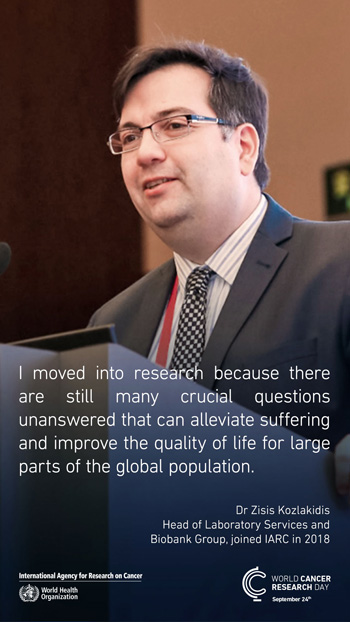❝I moved into research because there are still many crucial questions unanswered that can alleviate suffering and improve the quality of life for large parts of the global population.❞
Please introduce yourself. How long have you worked at IARC, and where did you work before?
My name is Zisis Kozlakidis. I am the Head of the Laboratory Services and Biobank Group (LSB) at IARC. I have worked in my current position for more than two years. I relocated to France after spending more than two decades in the United Kingdom, and in particular in London. I was previously based at the Division of Infection and Immunity and the Institute of Health Informatics at University College London, and the Cass Business School at City University of London.
What are the most interesting projects you are currently involved in, and why are they important?
I am currently involved in studies looking at the changes in clinical microbiology introduced by the adoption and adaptation of new technologies (such as high-throughput genomics) into routine practice. This is of particular importance because the ways in which new technologies are anticipated to have impacts on health care and public health are not necessarily all measurable or quantifiable yet. Such impacts, for example, include those associated with the rapid development, availability, accuracy, and interpretation of diagnostic tools and molecular biomarkers.
I am also involved in the field of biobanking (the structured collection, storage, and distribution of samples and associated data, used for research), where my research concentrates on two particular aspects. The first is the development and establishment of quality management systems in the field (such as evidence-based guidelines, International Organization for Standardization [ISO] standards, and best practices) that would ensure – as much as possible – the control of key pre-analytical factors and aid in the easier interpretation of downstream research outcomes.
The second aspect in the field of biobanking involves the support and capacity-building of biobanking infrastructure in resource-restricted settings, so that such settings can be better represented in the global research efforts now and in the long term. The underrepresentation of populations from low- and middle-income countries in cancer research is an international research gap that was already highlighted by IARC in 2011 and acted on by the creation of the Low- and Middle-Income Countries Biobank and Cohort Building Network (BCNet) in 2013. BCNet is coordinated by LSB and supports a number of initiatives across the world, in close collaboration with key partner organizations, such as the United States National Institutes of Health (NIH).
What do you do when you’re not doing research at IARC?
I work with established artists in the United Kingdom on visual arts (mostly), at the interface between art and science and the understanding of human nature.
Why did you move into research?
I moved into research because there are still many crucial questions unanswered that can alleviate suffering and improve the quality of life for large parts of the global population. Finding such answers and potentially impacting health care has been a key driving force.
Which personal scientific contribution are you most proud of?
One of the personal scientific highlights I’m most proud of is playing a key role in the integration of high-throughput, next-generation sequencing diagnostic tools into routine clinical practice in the United Kingdom – and since then in other locations across the world. This was a great personal and professional challenge because it involved not simply solid scientific evidence but also close collaboration with private partners and the development of leadership, financial, and organizational behaviour aspects over a number of years.
What is something you do now because of research you’ve read?
I have been steadily developing an interest in clinical and laboratory leadership skills and how those can become taught and transferable. It has been clear over the years that technology and training can only take one so far – there needs to be strong leadership supporting such initiatives throughout and completing the rich tapestry of requirements for an effective implementation of change in research and health care.
